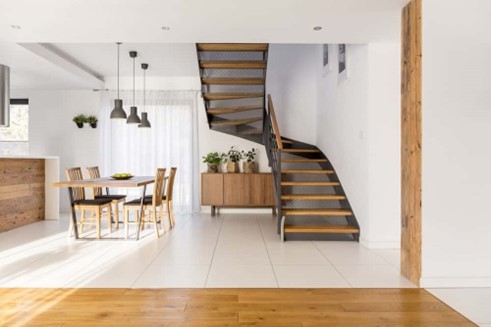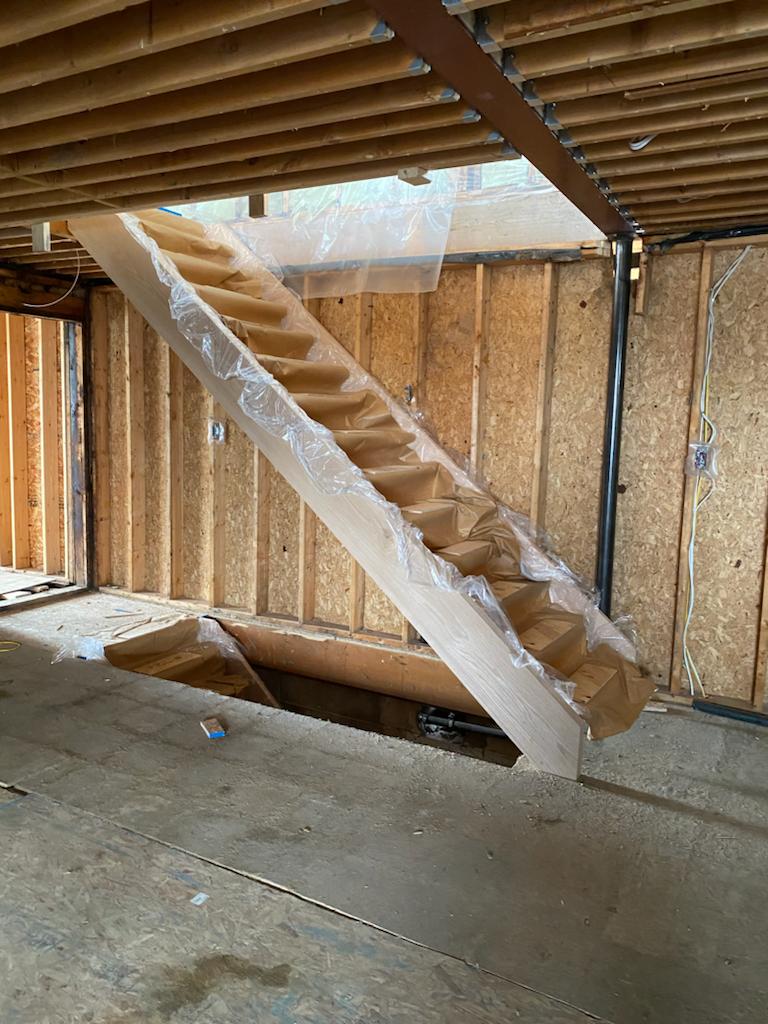Staircase Renovation
staircase remodel
A staircase is often the focal point of a home, commanding attention. A stunning staircase in the home design can set a new tone for the entire interior. Whether it’s a grand spiral staircase or a simple, elegant design, a well-executed staircase can elevate the aesthetic of any space. That enhances a home’s overall look and feel and can significantly increase its resale value. Homeowners who invest in a thoughtful and well-planned Staircase Renovation can expect a significant return on their investment, making it a wise decision for those looking to transform their living spaces.

Types of stairs for renovation
Signs That Staircase Needs Staircase Renovation
Although staircases are a crucial element of a home’s design, they can also be one of the most overlooked areas when it comes to maintenance and upkeep. Over time, stairs can become worn, outdated, or even unsafe, signaling the need for a remodel. Some common signs that your staircase is due for a makeover include:
- Worn or Damaged Treads and Risers
- Creaking or Unstable Steps
- Outdated or Mismatched Materials
- Lack of Safety Features, Such as Handrails or Proper Lighting
- Insufficient Space or an Awkward Layout
Recognizing these issues and addressing them through a specialized and appropriate Staircase Renovation can transform the look and functionality of your home, making it a more inviting and safe environment for your family and guests.

Staircase Renovation Options: Refinishing, Replacement, Resurfacing
When it comes to staircase remodels, homeowners have several options to choose from. Each of the options has its own set of benefits and considerations. So homeowners carefully consider their budget, design goals, and the overall condition of their existing staircase before making a decision.
- Refinishing: This involves sanding and refinishing the existing staircase, often with a new stain or paint color. Refinishing is a cost-effective option that can breathe new life into an outdated or worn staircase.
- Replacement: For homeowners who want a more significant transformation, a complete staircase replacement may be the way to go. This involves removing the existing staircase and installing a brand-new one, allowing for greater customization and design possibilities.
- Resurfacing: Resurfacing is a middle ground between refinishing and replacement, where the existing staircase structure is retained, but the treads and risers are replaced with new materials, such as tile, stone, or wood.
How to Staircase Remodel in 7 Steps
The staircase remodel steps involve updating or transforming an existing staircase to improve its appearance, functionality, and safety. Generally, Staircase Renovation could include replacing the railing, adding new treads and risers, refinishing the wood, or changing the overall design of the staircase. The process may involve removing the existing components, preparing the surface, installing new materials, and finishing with paint or stain. It’s important to carefully plan out the staircase remodel and consider factors such as safety, building codes, and design aesthetics.
Here is a detailed explanation of the typical steps involved in a staircase remodel:
1. Planning and Design:
The first step in Staircase Renovation is to carefully plan and design the desired changes. This involves considering factors such as the overall style and aesthetic of the staircase, the materials to be used, the budget, and any safety requirements or building codes that need to be met.
2. Demolition:
If necessary, the existing staircase components are removed, including treads, risers, balusters, and railing. Care should be taken during demolition to avoid damaging surrounding walls or structures.
3. Repair and Preparation:
To redo old staircase, any damaged or worn-out parts of the staircase are repaired or replaced. The surfaces are cleaned, sanded, and prepared for the installation of new materials.
4. Installation:
New components such as treads, risers, balusters, and railing are installed according to the design plan. This may involve cutting materials to size, fitting them securely in place, and ensuring that they meet safety standards.
5. Finishing:
To refinish steps, once the new components are installed, the staircase is finished with paint, stain, or sealant to protect and enhance the appearance of the wood or other materials.
6. Safety Checks:
Before completing the staircase remodel, a thorough safety inspection should be conducted to ensure that the staircase meets all relevant building codes and safety standards.
7. Final Touches:
The final step in a staircase remodel is to add any finishing touches such as decorative elements, lighting fixtures, or accessories that enhance the overall look of the staircase.

Choosing the Right Materials for Staircase Renovation
The materials you select for your staircase remodel can have a significant impact on the outcome. From the treads and risers to the handrails and balusters, each component plays a crucial role in the overall aesthetic and functionality of the staircase.
Some of the most popular material choices for Staircase Renovation include:
Material | Architectural Style | Indicator Properties |
Wood | Classic & Timeless Option | – Warm and Inviting Look – Adaptability with A Variety of Stains and Finishes |
Stone (Marble, Granite, Or Limestone) | Popular Styles for Luxurious Homes | Elegant, Durable, and Sophisticated |
Metal (Steel Or Wrought Iron) | Contemporary & Industrial-Inspired | Striking Visual Element to A Home |
Glass | Modern Architectural Style | – The Illusion of A Floating Design – Adding A Touch of Elegance and Transparent to Any Space |
Tile | Traditional Architectural Style | – Versatile and Easy to Maintain – Visually Appealing Choice – Practical Especially in High-Traffic Areas |
When selecting materials to restore old stairs, it’s essential to consider factors such as durability, maintenance requirements, and how well the chosen materials will integrate with the overall design of the home.
Description of Before and After Staircase Renovation Examples:
- Transforming a dated, worn wooden staircase into a modern, minimalist design with sleek, glass-paneled railings and a fresh, light-colored wood finish.
Transforming a cramped, outdated spiral staircase with a spacious, open-concept design featuring a striking, contemporary metal staircase with a sculptural, floating appearance.
- Transforming a drab, utilitarian staircase with elegant, marble-inspired tile, and a luxurious, high-end look that seamlessly integrates with the home’s overall aesthetic.
Converting Old Staircase to Look New and Modern by Stair Replacement
The stair replacement steps involve completely removing an old staircase and installing a new one in its place. This could be necessary if the existing staircase is damaged, unsafe, or outdated. The replacement process typically involves the demolition of the old staircase, preparation of the space for the new staircase, installation of the new components (treads, risers, railing, etc.), and finishing touches such as painting or staining.
- Assessment & Planning: Style, materials, budget, and any safety or building code requirements.
- Demolition: Treads, risers, balusters, railing, and any other components.
- Preparation: Cleaning, leveling, and making any necessary structural adjustments.
- Installation: Fitting and securing treads, risers, balusters, and railing in place, cutting materials to size, making adjustments for a precise fit, and ensuring that all components are securely attached.
- Finishing: paint, stain, or sealant to protect and enhance the appearance of the materials.
- Safety Checks: Checking for proper tread and riser dimensions, baluster spacing, handrail height, and overall stability.
- Final Touches: Adding accessories, trim pieces, or other decorative elements to enhance the overall look of the staircase.

Redoing Worn Out Stairs in Staircase Renovation Process
The redoing old stairs process involves refurbishing or renovating an existing staircase to improve its appearance, functionality, safety, or overall condition. This process can be a cost-effective way to update the look of your stairs without completely replacing them. Here is a detailed explanation of the steps involved in redoing stairs steps:
- Assessment and Planning: The first step in stair refinishing is to assess the current condition of the staircase and determine the goals for the renovation. This may involve identifying issues such as worn treads, loose balusters, damaged handrails, or outdated design elements that need to be addressed.
- Repair and Replacement: Any damaged or worn components of the staircase are repaired or replaced as needed. This may include fixing loose treads, replacing broken balusters, repairing damaged handrails, or reinforcing weak structural elements.
- Refinishing: The existing staircase is refinished to improve its appearance and protect the materials. This may involve sanding down old finishes, applying new paint or stain, and adding a protective sealant to enhance the durability and aesthetics of the stairs.
- Upgrading: Upgrading in refinishing stairs may involve adding new features or design elements to enhance their functionality or style. This could include installing new handrails, balusters, and newel posts, or adding decorative elements such as stair runners or lighting fixtures.
- Safety Enhancements: Safety considerations are an essential part of redoing old stairs Ensuring that the staircase meets building codes and safety standards is crucial. This may involve adjusting tread and riser dimensions, improving baluster spacing, adjusting handrail height, or reinforcing structural elements for stability.
Tips for Maintaining Newly Staircase Renovation
Once the Staircase Renovation is complete, it’s essential to maintain the investment by following a few simple tips:
- Regular Cleaning:
- Gentle Cleaning Products
- Periodically Inspect for Wear and Tear
- Refinish or Reseal as Needed
- Ensure Proper Lighting
By following these maintenance tips for stair resurfacing, homeowners can extend the life and preserve the beauty of their newly renovated staircase, ensuring it remains a stunning and functional focal point of their home for years to come.






